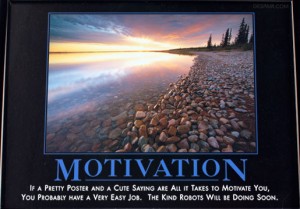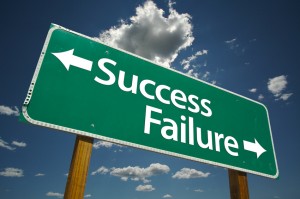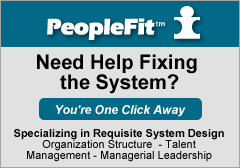The Bright Side of the Underutilized (Overcapable) Employee
By Michelle Malay Carter on November 18, 2009
 Today we will look at the positive behaviors a manager might observe in an employee that is underutilized, aka over capable of the work required of his role.?
Today we will look at the positive behaviors a manager might observe in an employee that is underutilized, aka over capable of the work required of his role.?
This post is number two in a series of four.? The series titles and links are listed below.
?
- Possible Negative Manifest Behaviors of an Underutilized Employee
- Today’s Post – Possible Positive Manifest Behaviors of an Underutilized Employee
- Possible Negative Manifest Behaviors of an Over committed Employee (not yet cognitively capable of the work level required of the role)
- Possible Positive Manifest Behaviors of an Over committed Employee
Even when an underutilized employee is bringing benefits to your organization at a discounted price (you are paying for a lower level of work than?the capability they are bringing), this can be short lived, so?beware that this situation may be temporary.?
Read over the list and let me know if it holds true to your experience. Does it shed light on a current situation? Is this you?
Positive Behaviors a Manager Might Observe in an Under Utilized Employee
- Gets work done more quickly than peers and/or more quickly than you expect.
- Does the work you assign and adds to it.
- Does extra work you have not assigned. (Creates work.)
- Improves and expands upon current practices, policies, products, or services.
- Is in a different class than peers – Coaches and helps peers with their work. Is seen as a peer leader.
- Anticipates what you are going to say.
- Asks complex questions (that may stretch or stump you).
- Serves as your go-to employee.
I’m OK.? You’re OK.? Let’s fix the system.
Image credit to Despair Inc. This poster is available for purchase.
Filed Under Requisite Organization | Comments Off on The Bright Side of the Underutilized (Overcapable) Employee
The Dark Side of the Underutilized Employee – Fire them or promote them?
By Michelle Malay Carter on November 13, 2009
 What to Do About Attitude Problems
What to Do About Attitude Problems
One of my most popular articles is What To Do About Attitude Problems?? Promote them!? This article explores the negative behaviors a manager might experience not because an employee is unqualified for a job, but because she is cognitively overqualified.?
As I’ve said before, high capability does not always mean high performance, especially when an employee is bored and mismatched to his role.? Some of a manager’s biggest problems come from those who could do the role but don’t, won’t, or make everyone miserable in the process!? Unfortunately, organization’s frequently show their young, high potentials to the door, rather than harnessing their capability for the organization’s benefit.
A Managerial Leadership Diagnosis Tool
When we conduct Talent Pool Evaluations for clients, managers really appreciate being given a diagnostic list of behaviors – both positive and negative – that they might observe in an underutilized employee.? PeopleFit research shows about 20% of employees are underutilized and could be handling higher level roles.
This post is the first in a series of 4 diagnostic lists.??In this series, we’ll?explore:
- Possible Negative Manifest Behaviors of an Underutilized Employee
- Possible Positive Manifest Behaviors of an Underutilized Employee
- Possible Negative Manifest Behaviors of an Over committed Employee (not yet cognitively capable of the work level required of the role)
- Possible Positive Manifest Behaviors of an Over committed Employee
Read over the list and let me know if it holds true to your experience.? Does it shed light on a current situation?? Is this you?
Negative Behaviors a Manager Might Observe in an Under Utilized Employee
- Complains of being bored – despite having work to do.
- Is in a different class than peers ? considered arrogant, impatient, or showy.
- Does not respect your authority.
- Questions or gossips about your capability as a manager.
- Does not want to pay his dues.
- Tries to tell you how to do your work.
- Is cynical, condescending, and/or complains about how things should be.
- Becomes unmotivated or apathetic after 3- 9 productive months on the job.
- Goes over your head and/or seeks guidance from higher level managers.
- Lackluster performance – despite capability.
- Works on things other than what you have assigned.
- Exploits the system. Finds loopholes. Bends the rules.
I’m OK.? You’re OK.? Let’s fix the system.
Image credit to Despair Inc.? This poster is available for purchase.
Filed Under Employee Engagement, High Potential, Managerial Leadership, Requisite Organization, Talent Management, Work Levels | 3 Comments
Missed Opportunities to Rescue Dugard Linked to Poor Employee Screening or Poor Pay?
By Michelle Malay Carter on November 5, 2009
 According to the San Francisco Chronicle, “State parole agents fell down on the job again and again during the 10 years they supervised sex offender Phillip Craig Garrido, failing to check out clues that could have led to alleged kidnap victim Jaycee Dugard.”? [emphasis mine]
According to the San Francisco Chronicle, “State parole agents fell down on the job again and again during the 10 years they supervised sex offender Phillip Craig Garrido, failing to check out clues that could have led to alleged kidnap victim Jaycee Dugard.”? [emphasis mine]
Parole Agent Work is Level Two Work
If you follow my blog, you know that work exists in levels, and we can classify roles by work level.? If a parole agent’s job involves sorting information to identify relevant clues and then adding clues together to draw conclusions, then it is level two work.
Level Two Work Calls for Level Two Capability
If we add to that the fact that people’s problem solving capability occurs in increasingly complex levels, we know that in order to be competent in a parole officer role, one would need at least level two capability.
Why Would Someone Ignore Clues that Could Save a Life?
Finally, because I believe people are wired to work and want to contribute at work, I have to ask myself, why would a parole officer IGNORE clues?? I daresay that?maybe they weren’t?ignored, but rather they were not RECOGNIZED as clues in the first place.? This phenomenon would occur if the state of California had level-one capable officers employed in level two roles.
Where is the System Broken?
So is the recruiting system designed to screen specifically for level-two capability?? If not, you might expect something like this tragedy to?occur.? Additionally, we have to ask is the system set up to provide level-two felt-fair compensation for this role?? You really do get what you pay for, and level-one pay will draw level-one capable people, who will not be competent in a parole officer role.? Again, knowing this, we could predict this type of tragedy.
Just another example of how understanding work levels could change the world and save lives.? I’m OK.? You’re OK. Let’s fix the system.
Filed Under Accountability, Felt Fair Compensation, Talent Management, Work Levels | Comments Off on Missed Opportunities to Rescue Dugard Linked to Poor Employee Screening or Poor Pay?
Ford not only Survives, but Thrives? Was it Science-based Organization Design and Talent Assessment?
By Michelle Malay Carter on November 3, 2009
 Good news for Ford Motor Company this week as it earned a third-quarter profit of almost $1 billion and expects to be “solidly profitable” in 2011 in its North American business.? Has Ford turned the financial corner?
Good news for Ford Motor Company this week as it earned a third-quarter profit of almost $1 billion and expects to be “solidly profitable” in 2011 in its North American business.? Has Ford turned the financial corner?
I was reminded last week at the Global Organization Design Society’s International Conference that Ford Motor Company worked with Elliott Jaques and The Levinson Institute in the areas of requisite organization design and talent assessment years back.
Was a work-levels, science-based approach to organization design and talent assessment a contributor to Ford’s sole survivor status amongst the big three?
Filed Under Organization Design, Requisite Organization, Talent Management, Work Levels | Comments Off on Ford not only Survives, but Thrives? Was it Science-based Organization Design and Talent Assessment?
The GO Society’s 2009 World Conference in Buenos Aires
By Michelle Malay Carter on October 23, 2009
 I’m attending and presenting at the GO Society’s World Conference this upcoming week.? Can you imagine a group of geeks from around the world?mezmerized by talk of?work levels and Requisite Organizations until late in the evening each night?? Sounds like a slice of heaven, doesn’t it?
I’m attending and presenting at the GO Society’s World Conference this upcoming week.? Can you imagine a group of geeks from around the world?mezmerized by talk of?work levels and Requisite Organizations until late in the evening each night?? Sounds like a slice of heaven, doesn’t it?
I doubt that I will be able to keep the blog fires?burning during that time, because I don’t want to miss a minute of the dialogue.? So, for now, you will have to talk amongst yourselves.?
Discussion Topic:??
Why does Management Science have yet to adopt a universal set of definitions, practices, accountabilities, authorities, standards, and rules of engagement?? The plumbing industry managed to do it nearly a century ago.
I’m OK.? You’re OK.? Let’s fix the system.
Filed Under Executive Leadership, Requisite Organization, Work Levels | Comments Off on The GO Society’s 2009 World Conference in Buenos Aires
What Does Your Franchise Fee Pay For? Work Levels 5, 4, and 3
By Michelle Malay Carter on October 18, 2009
 The franchise model has been responsible for many an American dream (insert your country here as well).? And what are you buying when you purchase a franchise?
The franchise model has been responsible for many an American dream (insert your country here as well).? And what are you buying when you purchase a franchise?
- Level 5 – The brand, the business model, the strategy
- Level 4 – The infrastructure, the future focus strategic work, operational change decisions
- Level 3 – The operational processes for consistency, best practices for efficiency and waste minimization, contingency planning.
A Single Franchise Unit Can Be Managed at Level Two
Franchising allows someone currently capable of level 2 work to run an effective business by “outsourcing” the higher level work.?
What is Level Two Work?
Level 2 work consists of day to day operations, dealing with customers, scheduling and training staff, and this is the accountability of the franchise owner.
Win-Win
When you consider that Elliott Jaques, the father of the Requisite Organization model, estimated that only 10% of the world’s adult?population has capability at level three or higher, the franchise model allows a large percentage of people to complement their natural gifts in a way that allows them to earn a generous living for themselves and their families.
Da, da, da, da, daaaa.? I’m lovin’ it.
Filed Under Organization Design, Requisite Organization, Strategy, Talent Management, Work Levels | 2 Comments
What is Requisite Organization? The Elevator Speech
By Michelle Malay Carter on October 13, 2009
 I work for PeopleFit, a management consulting firm that specializes in:
I work for PeopleFit, a management consulting firm that specializes in:
Organizational engineering, talent assessment,?and designing managerial leadership systems rooted in Elliott Jaques’ meta-model, Requisite Organization.
What a marketing nightmare – creating demand for services that most executives have never conceived of!
Let’s Learn from Other Professions!
While most professions and industries have standards of practice which weave a common thread throughout the work done, managerial leadership is lacking the adoption of universal rules of engagement.
- Can you imagine the chaos if your bookkeeper decided to “shake it up” and put debits on the right and credits on the left? Bounce
- Have you ever visited a house where the plumber put hot on the right and cold on the left?? Ouch!
The Plumbers Figured It Out
Here’s what Wikipedia has to say about what the plumbers were facing in 1926 (Does it sound like the state of management today?)
In 1926, a group of Los Angeles plumbing inspectors recognized that there were no uniform requirements for the installation and maintenance of plumbing systems, and at that point in time disease was rampant, a lot of it spread through improper sanitation. Disorder in the industry was the result of widely divergent plumbing practices and the use of many different, often conflicting, plumbing codes by local jurisdictions. It was these plumbing inspectors that understood the necessity of developing a model code that could be uniformly applied across jurisdictions.
So what is Requisite Organization??
Requisite is a meta-model that combines science-based theory regarding levels of work and human capability and the two universal values of trust and fairness and endeavors to:
- Create organizational conditions within which most people can be successful.
- Enable productive work.
- Eliminate the wasted energy used to compensate for three structural flaws – 1. Organizational layering errors 2. Mismatching people to roles ?3. Mismatching people to managers.
- Design explicit “rules of engagement” across functions.
- Create explicit, uniform, and universal minimum accountabilities and authorities for three sets of organizational players – 1. Employees 2. Managers 3. Managers-once-removed.
- Create a science-based methodology for matching people to roles.
Trust and Fairness – Core Values
I believe in Requisite Organization because you can always trace the principles and policies within it back to a desire for trust and fairness – two precursors to employee engagement.?
Human Dignity
The other thing that stands out is respect for human dignity.? Requisite organization purports that nearly all organizational dysfunction can be traced to poor structure and systems, not deficient employees.?? (BTW – I pasted that last sentence from Wikipedia.? A fun fact for you to know is that?I was the one who wrote most of Wikipedia post regarding Requisite Organization.)
Results
Finally, it works!? After over 10 years of working with the model, I am convinced it is valid and reliable, and managers appreciate it.? Sure, it takes courage, discipline and practice to convert an organization to a fully requisite organization, but managers ultimately see that it is worth the effort.
I’m OK.? You’re OK.? Let’s fix the system.
What has your experience been?
Filed Under Accountability, Employee Engagement, Organization Design, Requisite Organization, Talent Management, Work Levels | Comments Off on What is Requisite Organization? The Elevator Speech
Human Resource Work Stratified by Requisite Work Levels
By Michelle Malay Carter on October 8, 2009
 I have a colleague who will be speaking to a society of Human Resource Professionals on the topic of work levels, and it’s meta model, Requisite Organization, developed by Elliott Jaques.? He asked me for help in developing?a hierarchy of typical work within a Human Resource function.?
I have a colleague who will be speaking to a society of Human Resource Professionals on the topic of work levels, and it’s meta model, Requisite Organization, developed by Elliott Jaques.? He asked me for help in developing?a hierarchy of typical work within a Human Resource function.?
Requisite Work Levels
Since work levels is a recurring topic here at Mission Minded Management, I thought it might be helpful to publish another set of “real life” examples of work by level.
Sample Longest Task by Work Level:
Work Level 4:
Design and implement a comprehensive strategic talent management system. (2-5 years)
Work Level 3:
Write and implement the operational plan for the roll out of one element within a strategic talent management system. Build feedback loops, assess, and refine processes into a set of best practices. (1 to 2 years)
Work Level 2:
Manage a 4 – 12 month project to implement one section within a serial “roll out” of a new HR methodology or program.
Work Level 1:
Support HR department by providing products as defined, i.e reports, material production. Or by delivering administrative services as trained, i.e. inventory maintenance, scheduling, shipping. (1 day to 3 months)
What level of work is your role?
Filed Under Organization Design, Requisite Organization, Talent Management, Work Levels | 1 Comment
How To Motivate Employees – Newsflash: It’s Not a Manager’s Job
By Michelle Malay Carter on October 2, 2009
 Red Herrings
Red Herrings
Motivation is a side effect, not the goal.? Because we operate under faulty assumptions about work and human nature, well-intentioned managers, organizational development consultants, and human resource professionals spend a lot of time chasing red herrings.? I wrote an entire poem on this subject, Organization Design – Seek and Ye Shall Find.
What is a Manager’s Job?
So if it is not a manager’s job to motivate, what is a manager’s job??
- To effectively match people to roles (use a science based model to hire well),
- To practice effective managerial?leadership,?(click here for a list) and
- To create work enabling conditions.
When you do this, motivation will be a natural outflow of the conditions you have created.? Your job is to create the conditions.
Newsflash: Humans Are Wired to Work!? They Need Not Be Coerced and Bribed
Humans are wired to work!? If they are not motivated to work in the job they are currently holding, then that was a poor hiring decision.? If they are thwarted and frustrated when they try to work because they are working within faulty systems, fix the system rather than bribing them to push through the pain and craziness of working within a broken system!
Don’t Believe It?
I came across this video yesterday of some college students working quite diligently, not on their coursework, but working nevertheless.??My 11-year-old son is very bright but?is not much for?academics. This is the kind of activity I fear my college tuition check will eventually fund.
?
I’m OK.? You’re OK.? Let’s fix the system.
Filed Under High Potential, Managerial Leadership, Organization Design, Requisite Organization, Talent Management, Work Levels | 3 Comments
strategy+business and Ram Charan – Let’s Further Define “Altitude”
By Michelle Malay Carter on September 29, 2009
 In Author’s Choice:? What Is and Isn’t Micromanaging?,strategy+business discusses Ram Charan’s book about raising the level of corporate discourse, Owning Up: The 14 Questions Every Board Member Needs to Ask.
In Author’s Choice:? What Is and Isn’t Micromanaging?,strategy+business discusses Ram Charan’s book about raising the level of corporate discourse, Owning Up: The 14 Questions Every Board Member Needs to Ask.
The Right Altitude
Ram Charan uses the phrase, asking questions at the right altitude.? Once again, intuitive proof that we all sense work levels, but don’t have a language to speak about them.
If we didn’t have measures for distance, and we wanted to talk about altitude, we’d be stuck using words like high, medium, and low – relative terms that you and I could debate all day and not agree.? However, with measures like feet or meters, we have a common understanding and efficiency in our conversation.
Similarly, you and I could stand in a room and argue all day about whether the room was warm or cold and never come to an agreement.? But we could walk together to the thermostat and instantly agree on the temperature.
Let’s Create a Collective Understanding – Work Levels
Understanding work levels allows us to design work enabling organizations.? Understanding work levels and human capability to problem solve in levels allows for matching people to roles.? Understanding work levels allows us to match people with leaders.? Understanding work levels is foundation knowledge for management science.? Did I mention that I think you should understand work levels?
I’m OK.? You’re OK.? Let’s fix the system.
Filed Under Requisite Organization, Strategy, Work Levels | 2 Comments
